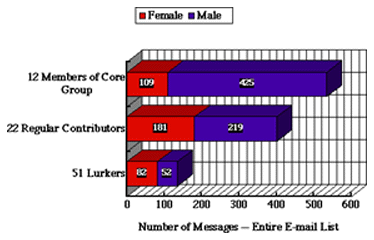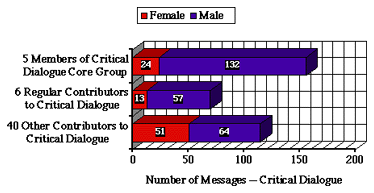


See also 11: "Core Group," "Regular," and "Lurker" Participation by Student Residents and 12: "Critical Dialogue Core Group" Participation.
For the e-mail list as a whole (13a):
For critical dialogue discussion (13b):
I find it troubling that both core groups, and critical dialogue in general,
should be so dominated by men. I can speculate that, as some researchers have
suggested, women and men prefer to use CMC for different purposes, as in face-to-face
interaction women demonstrate different conversational styles than men (e.g.,
the work of Deborah Tannen). I have some evidence for this conclusion in 08
and 09, where women's and men's perceptions and
actual behavior on the list are compared. We should be especially concerned,
as feminist scholars have emphasized, about the extent to which the kinds of
critical dialogue promoted in academia and the media that facilitate such dialogue
tend to be male-centered. In the case of Rinconada, it seems that some women
(Hillary, to be sure) were quite comfortable using the e-mail list and engaging
in the stereotypically- or historically-male point-counterpoint style of argumentation,
while many other women were not so comfortable doing so, including women who
were otherwise (f2f) socially and politically active in the dorm. I fear that
by using a traditional definition of critical dialogue, I may have to some degree
guaranteed these gender disparities in my results. To measure the potential
of CMC to overcome male domination of conversational spaces in academia more
truly or thoughtfully, perhaps we should re-think those categories and redefine
a critical dialogue based more on feminist principles.